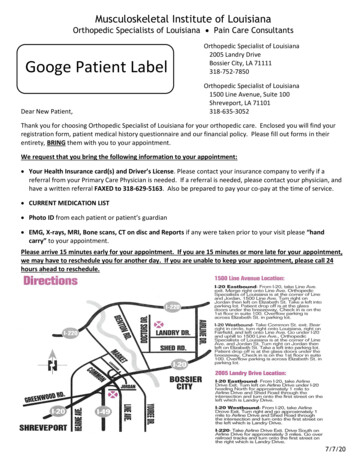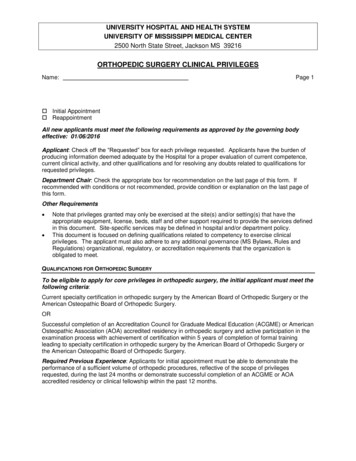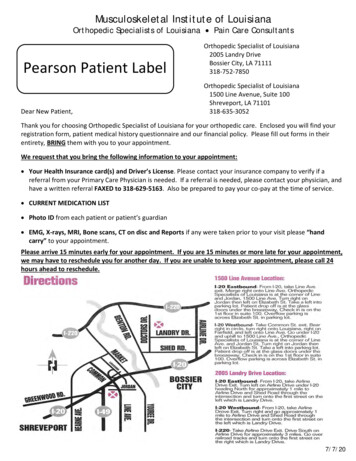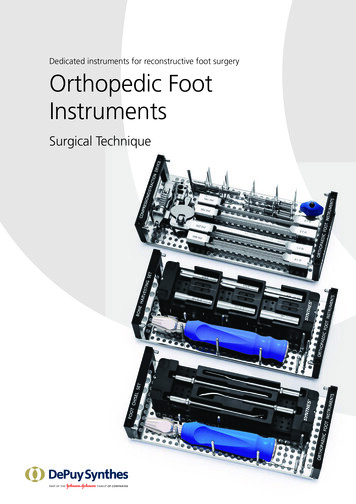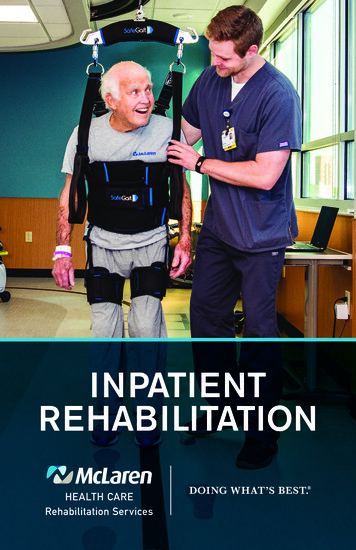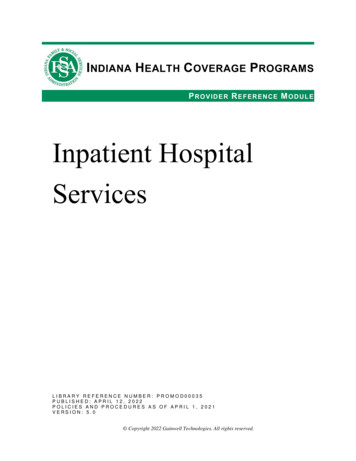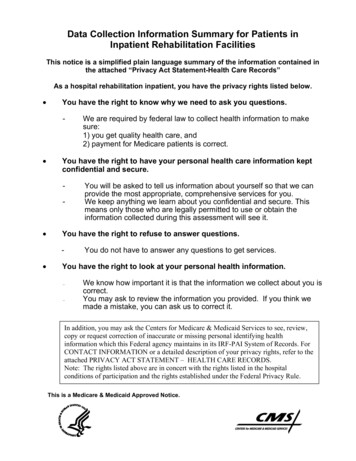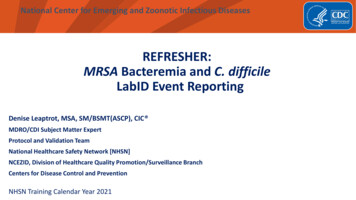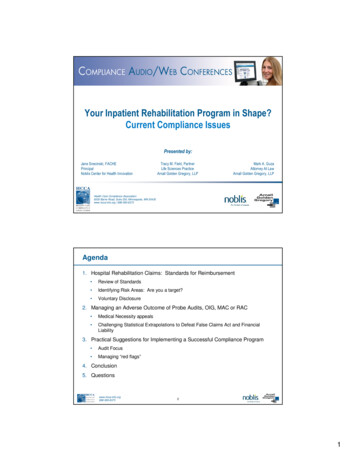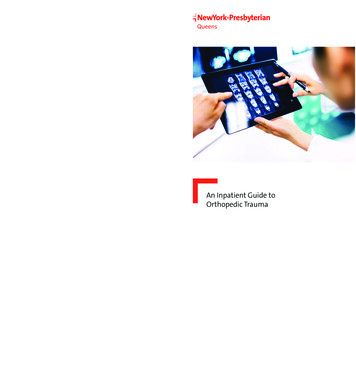
Transcription
NewYork-Presbyterian Queens56-45 Main StreetFlushing, NY 11355nyp.org/queens-orthoDepartment of Orthopedics & Rehabilitation718-670-255856-45 Main Street, 4 SouthFlushing, NY 11355Outpatient Occupational & Physical Therapy,Flushing1-855-37REHAB (1-855-377-3422)56-45 Main Street, 4 NorthFlushing, NY 11355Outpatient Occupational & Physical Therapy,Fresh Meadows1-855-37REHAB (1-855-377-3422)163-03 Horace Harding Expressway, Floor 2Fresh Meadows, NY 11365NewYork-Presbyterian Medical Group QueensOrthopedics and Sports Medicine Center,Fresh Meadows1-866-670-OUCH (1-866-670-6824)163-03 Horace Harding Expressway, 4th FloorFresh Meadows, NY 11365Orthopedics and Sports Medicine Center,Jackson Heights1-866-670-OUCH (1-866-670-6824)72-06 Northern Blvd, 2nd FloorJackson Heights, NY 11372Orthopedics and Sports Medicine Center,Sunnyside718-784-474747-01 Queens Blvd, Suite 403Sunnyside, NY 11104Downtown Flushing Multispecialty,Flushing718-888-0066136-56 39th Avenue, 2nd FloorFlushing, NY 11354Outpatient Occupational & Physical Therapy,Jackson Heights1-844-REHAB-01 (1-844-734-2201)72-06 Northern Blvd, 2nd FloorJackson Heights, NY 11372nyp.orgAn Inpatient Guide toOrthopedic TraumaBUSINESS CARD SLITS
Table of ContentsOVERVIEWTo Our Patients. 2Our Team . 4Phases of Care . 6BEFORE & AFTER SURGERYWhat to Expect Each Day . 9Common Issues and/or Complications afterTrauma. 11Rehabilitation.13FAQS & TERMSFrequently Asked Questions .15Trauma Terms 101 . 18INFORMATIONMy Information.22My Team . 23Contact Information and Locations.24
To Our PatientsYou have been admitted to the Orthopedic Trauma Service because your musculoskeletal systemhas been injured. Your musculoskeletal system is the medical term that is used to refer to your bones,joints, muscles, ligaments, and tendons. Orthopedic trauma surgeons are medical specialists whoare frequently consulted to care for injured people with fractures – also known as broken bones –and are a part of the larger team that starts you on your way to recovery.Our Emergency Department has been designated by the American College of Surgeons as a regionalLevel I Trauma Center and treats more than 1,000 adult and pediatric trauma cases each year.This designation means that a complete support staff of physicians is always available to treatlife-threatening traumatic injuries. The team includes specialists in surgery, neurosurgery,anesthesia, orthopedics, vascular radiology, and others.This booklet will introduce you to the team and will give you an idea of what to expect whilerecuperating here at NewYork-Presbyterian Queens as well as after you leave. We realize that youand your family will have many questions and concerns regarding your injury, treatments, recovery,and hospitalization. We also understand that unanticipated injuries can be a source of great anxietyand that having your once-normal life turned upside down by this unplanned turn of events isstressful. The more informed and educated you become about what we are doing to take care ofyou, the more comfortable you will be during this difficult time.We hope that this booklet will provide a solid foundation regarding NewYork- Presbyterian Queens,your injury, your treatment and recuperation. It uses common words and terms and is meant toadd to the information you receive from the medical care providers who are assigned to you whileyou are a patient at our hospital. Please do not hesitate to ask questions about any informationin this booklet. It is important for you to be an active participant as we work together to help youreturn to your pre-injury function.Jeffrey E. Rosen, MDChairmanDepartment of Orthopedics & RehabilitationNewYork-Presbyterian Queens2Elan M. Goldwyn, MDDirector, Orthopedic Trauma ServiceDepartment of Orthopedics & RehabilitationNewYork-Presbyterian QueensOVERVIEW
Working side by side with your Orthopedic Trauma Team, the inpatient occupational and physicaltherapists are another important part of your recovery process. Early mobility and exercises havebeen shown to speed up the rehabilitation process and return patients to their prior level offunction. Patients routinely receive therapy the day after surgery. Our therapists will work withyou to achieve your goals and maximize your functional independence. Therapeutic exercises,transfer training, and ambulation training are examples of some of the interventions performeddaily that are important for your recovery process. The occupational and physical therapists willfollow specific and detailed orders from your doctor and will coordinate your sessions with theinterdisciplinary team.We know that sometimes beginning therapy after an injury, fall, or surgery can be uncomfortableand even painful. We will help you work through this discomfort and want you to tell us ifsomething doesn’t feel right. We will all care for you with the same goal in mind. Your inpatientoccupational therapist, physical therapist, and physical therapy assistant are all here to help youreturn to your prior level of function as quickly and as safely as possible. We all look forward toworking with you toward your recovery.Sincerely,Nicole Manfield, DPTRehabilitation ManagerNewYork-Presbyterian QueensNewYork-Presbyterian QueensKnee and Hip Joint Replacement Programhas earned The Joint Commission’sGold Seal of Approval OVERVIEW3
Our TeamAttending Orthopedic SurgeonAn attending orthopedic surgeon is a medical doctor who has received extensive training in theart and science of performing surgery to treat diseases, injuries, and deformities of the musculoskeletal system. Your surgeon will be your main contact if you have any questions regarding yoursurgery.Resident PhysicianA physician-in-training certified to practice medicine under the supervision of an attendingphysician. A resident has a medical degree and is a fully qualified physician. On the trauma service,residents are completing a five-year program to specialize in orthopedic surgery. They are criticalmembers of our team and our attending surgeons rely on them for assistance.4OVERVIEW
Physician Assistants (PAs)Licensed to practice medicine under the supervision of a licensed physician, a PA can conductphysical exams, diagnose and treat illnesses, order and interpret tests, counsel on preventivehealthcare, assist in surgery and write prescriptions.AnesthesiologistAn anesthesiologist is a perioperative physician who provides medical care to each patientthroughout his or her surgical experience. This includes medically evaluating the patient beforesurgery (preoperative), providing a pain-free state and supporting life functions during surgery(intraoperative), supervising care including providing pain control after surgery (postoperative)and discharging the patient from the recovery unit.NursesRegistered nurses (RNs) or licensed practical nurses are responsible for your bedside nursing carefollowing your surgery. The nurses caring for you will follow the surgeon’s instructions to guideyour care and will provide education to you and your family about your health and safety needsrelated to your surgery.Occupational & Physical Therapists (OTs & PTs)OTs, PTs and PT assistants are licensed professionals that will work with you to restore yourfunction, improve mobility and decrease pain with the goal of reestablishing your prior level offunction. They will focus on activities of daily living and mobility in the home, workplace and,community while maintaining your physical, physiological and emotional health.Case Manager / Social WorkerA registered nurse case manager/social worker will monitor your hospital stay from admission todischarge and will work closely with your doctor to expedite your hospital care. Your social workerwill assist with arranging accommodations to suit your needs at home and/or with placement ina rehabilitation facility if necessary. He or she can also provide counseling services for patients andtheir families.OVERVIEW5
PHASES OF CAREThis section of the guide has been developedto help you understand the different phasesof care you may receive as a trauma patientat NewYork-Presbyterian Queens.Emergency Department (ED)Almost all of the patients admitted to theOrthopedic Trauma Service are first evaluatedin the Emergency Department (ED) and thenmoved directly to the operating room, intensivecare unit, or a regular hospital bed dependingon the seriousness of the injury.Your care begins with an ED doctor. This caremay include diagnostic studies (i.e. x-rays,CT scans, etc.), receiving pain medications orantibiotics, and contacting appropriate specialistsincluding members of the Orthopedic TraumaService. When you are first seen by a memberof the Orthopedic Trauma Service in the ED,you will provide general information aboutyour medical history and undergo a physicalexamination.Once you are admitted to the OrthopedicTrauma Service, additional orthopedic/medicalhistory, x-rays and/or CT scans may be needed.When all information is obtained and tests arecompleted, your injury and treatment optionswill be discussed with you. This could includeno treatment, a sling, brace, cast or splint, and/or surgery. While you are in the ED, you maybe seen by many physicians and support staffto understand the seriousness of your injury.Our physicians treat some patients who areextremely ill, and the sickest patients must begiven priority. While you are there it may or maynot be possible for your family or friends tovisit you. However, your family members maycontact the ED staff regarding progress aboutyour condition.6OVERVIEW
Treatment Using a Sling, Brace, Cast or SplintThe purpose of applying a cast or splint is to hold broken bones in place. This treatment allowsbones to heal straight and will help to decrease your pain. If the bone is displaced (not straight)then a reduction (straightening) may need to be performed first. Prior to reducing (straightening)your fracture, we will give you pain medication to minimize your pain.SurgeryYour condition and the nature of your injury will dictate the urgency and timing of surgery. If theOrthopedic Trauma Service determines that you need emergency surgery, you will be taken directlyfrom the ED to the operating room. Most orthopedic surgeries are completed within 24 to 48 hoursof the injury. If you are admitted to the Intensive Care Unit (ICU) or to our inpatient orthopedicunit prior to surgery, a member from the Orthopedic Trauma Team will meet with you and yourfamily to: Discuss what will happen during your surgery, how the team will repair your injury andwhat you can expect during your recovery.Explain all of the risks and benefits associated with the surgery and any alternativetreatment options that may exist.Obtain written consent (permission) for the surgery.Any questions or concerns you have should be discussed with your Orthopedic Trauma Teamso that you understand what will happen during your surgery and have an idea of what toexpect afterward.Weekend and Late-Night SurgeryThe Orthopedic Trauma Service is available 24/7/365 to provide all necessary musculoskeletal care,including surgery. However, weekend and late-night surgery are avoided unless necessary. This is doneto ensure that the full complement of hospital staff is immediately available should the need arise.Preparing for Your SurgeryUnless you are having emergency surgery, in preparation for anesthesia you will be instructed tonot eat or drink anything for at least eight hours prior to surgery to prevent complications duringyour time under the medication.This will usually exclude any medications that you may take. Depending on your age and othermedical conditions, you will also be seen by a medical doctor either the day before or day of yoursurgery to have a complete physical exam to make sure that you are healthy enough to undergothe procedure. Depending on your current condition and overall health, you may be required totake more tests and/or see a specialist, such as a cardiologist or a pulmonologist, to make sure itis medically safe to proceed with your surgery.OVERVIEW7
When it is time for your surgery, you will be brought to the operating room holding area where anurse will prepare you for your operation. You will also be seen by your surgeon to review theprocedure and “sign” the site of the operation to confirm the part of the body requiring surgery.Your anesthesiologist will also see you in the holding area and will discuss your options foranesthesia. The two most common options are:General Anesthesia: a treatment that puts you to sleep during surgical procedures so you don’tfeel or remember anything that happens. General anesthesia is given through intravenous drugsor inhaled gases.Regional Anesthesia: an anesthetic is injected into your body and numbs the area that is beingoperated on.Postponement or Surgery DelayIn the event that your surgery has to be postponed or delayed, you will be informed as soon aspossible. Your nurse is the primary point of contact between you and the Orthopedic Trauma Team,and can provide you with information regarding your surgical schedule including any delays.Because this is a trauma service, unexpected emergencies may result in a delay in your surgerywhich may include postponing to the following day. If that occurs, we will allow you to eat again.During and following your surgery, your family can wait in the family waiting area just outsideof the operating room. After your surgery, the surgeon will return to the waiting area to speakwith them. You will be taken to the recovery room where you will stay for several hours while yourecover from your surgery and anesthesia. Your family may visit you for a short time in the recoveryroom with permission from the nurse. Once you are ready, you will be sent back to your hospitalroom. If there is a need for additional monitoring, you may temporarily be sent to another floorsuch as the Step Down Unit or Intensive Care Unit (ICU).8OVERVIEW
What to ExpectEach DayThe following information will give you an idea of what to expect on a daily basis, and who yourprimary point of contact is, while you are an inpatient at NewYork-Presbyterian Queens.RoundsThe Orthopedic Trauma Team, including your attending orthopedic surgeon and several orthopedicresidents, will make rounds every morning to examine your injuries and vital signs. They will alsochange dressings and review any new laboratory results to update you on your care and what isplanned for you that day.You are strongly encouraged to ask any questions or voice any concerns that you may have duringthis time. If your orthopedic surgeon is in the operating room (OR) at this time, you may expressany questions or concerns you have to your resident, physician assistant (PA) or floor nurse.BEFORE & AFTER SURGERY9
Physical/Occupational TherapyOnce your orthopedic surgeon or resident has placed an order for physical therapy in your chart,a physical therapist (PT) will evaluate you in your room within 24 hours. During this initialevaluation, your PT will review your medical history, including your level of function prior to thetrauma. This is done to assess how to work with the Orthopedic Trauma Team to get you backto your prior level of activity as safely and quickly as functionally possible.Your physical therapist will work with you to develop the goals you would like to achieve while youare a patient. Your physical therapist will do an assessment of what you can currently manage,such as walking, strength level, balance, and coordination and make recommendations based onthis to help you meet your goals. Your daily physical therapy treatment rate is discussed with yourphysical therapist and surgeon in coordination with your goals.Occupational therapy may also be ordered by your surgeon during your stay. An occupationaltherapist (OT) will then evaluate your current level of function and your independence with dailyactivities. The OT will assess your ability to safely perform activities such as dressing, bathing,grooming, and toileting to ensure a safe and appropriate discharge.In collaboration with the Orthopedic Trauma and the interdisciplinary team, Physical andOccupational Therapy may suggest recommendations about your discharge rehabilitation placeof service (home, acute, sub-acute, etc). Your physical/occupational therapists may also makerecommendations to your case manager/social worker about discharge durable medicalequipment (DME, such as commodes, crutches, canes, etc.) that would benefit your recovery.Point of ContactYour floor nurse is in contact with all members of your musculoskeletal care team to ensure yourcare plan is followed through as instructed. The floor nurse will be your primary point of contactwhile you are an inpatient at NewYork-Presbyterian Queens. Please do not hesitate to share yourquestions or concerns.10BEFORE & AFTER SURGERY
Common Issues and/orComplications after TraumaOur Emergency Department has been designated by the American College of Surgeons as aLevel I Trauma Center and treats more than 1,000 adult and pediatric trauma cases each year.This designation means that a complete support staff of physicians is always available to treatlife-threatening traumatic injuries, and includes specialists in surgery, neurosurgery, anesthesia,orthopedics, vascular, radiology, and other areas.Eating and DrinkingIf you are scheduled for surgery, you may not eat or drink anything for eight hours prior to thesurgery (also known as NPO). This is done to prevent complications during anesthesia.After your surgery, we will allow you to eat and drink but we recommend that you start slowly withbland foods. Unfortunately, nausea and vomiting are common problems following surgery due tothe after-effects of anesthesia, as well as pain medications. Your doctors will prescribe medicationsfor you to decrease nausea if this should occur.BEFORE & AFTER SURGERY11
Pain MedicationsWe understand that your injury has likely caused you to experience a significant amount of pain.We do not want you to be in pain and will do everything necessary to try to minimize the painyou are experiencing. This may include prescribing mild pain pills, stronger narcotic pain pills,pain medicines injected into your skin, and/or patient-controlled analgesia (PCA). A PCA is a pumpthat delivers pain medicine directly into your vein whenever you press a button. You can press thebutton as many times as you need without worrying that you are taking too much.Side EffectsTwo common side effects of all pain medication are constipation and nausea. Your doctors willprescribe you stool softeners and anti-nausea medications to try to minimize these side effects.Blood ClotsAfter a trauma, especially to the legs, patients are at an increased risk of developing blood clots intheir veins that may then break off and travel to the lungs. These clots are due to the trauma itself,as well as the prolonged time that you are spending in bed. In order to minimize your risk ofdeveloping a clot, your nurse will place inflatable “squeezers” (venodynes) around your legs whileyou are in bed in order to increase circulation. You may also receive daily injections of a bloodthinner to prevent clot formation. If you still develop a clot, despite these measures, you will betreated with long-term blood thinners to dissolve the clot.SmokingIt has been proven that cigarette smoke delays bone healing and increases risks associated withgeneral anesthesia. Throughout your hospitalization and your period of recovery, we stronglyrecommend that you try to stop smoking. We understand that this is not an easy thing to do andif you need assistance we can prescribe nicotine patches and offer smoking cessation counseling.For further information, please visit www.nysmokefree.com for the New York State Smokers’Quitline to obtain more information to stop smoking.Coughing/PneumoniaProlonged bed rest, as well as anesthesia, may cause you to develop a cough and/or not breathenormally. After your surgery, your nurse will give you an “incentive spirometer.” This is a smallbreathing tube that you will blow into throughout the day. By using this device, your lungs willfunction better and decrease your chance of developing pneumonia. We recommend using thisdevice at least ten times during the hours you are awake.12BEFORE & AFTER SURGERY
RehabilitationThe recovery from your injuries will begin hereas an inpatient and will continue once youare discharged from NewYork-PresbyterianQueens. Your recovery, in most cases, maycontinue over several months. Depending onthe type of injury and the support you receiveat home, you may continue your recovery ata different type of hospital setting or as anoutpatient. Please discuss all of these optionswith your family and your caseworker/socialworker. Your caseworker/social worker willalready have your medical recommendationsfrom your Orthopedic Trauma Team and willhelp coordinate the transition from one settingto the next.Rehabilitation HospitalDepending upon the severity of your injury,you may continue your recovery at an inpatientrehabilitation setting. This is typically forpatients who need a considerable amount ofrehabilitation care over a period of time. In thisenvironment, your care will continue with anew team of therapists, nurses, and physiciansto help you work towards your goals.Skilled Nursing FacilityIf you need less medical supervision upondischarge from the hospital but are notindependent enough to return home, a skillednursing facility (SNF) may be an option for you.In this setting, you will also continue to workon your strengthening and rehabilitation goals.BEFORE & AFTER SURGERY13
Home Health CareIf the Orthopedic Trauma Team has established that you have progressed to a point where it ismedically safe for you to continue your recovery in your home, you may be discharged directlythere from the hospital. If this is the case, your caseworker/social worker will arrange for homehealth care to send a team of therapists and/or nurses to you in your home, as needed. They willhelp you to continue your therapy and teach your family how to take care of you while you areprogressing to a more independent lifestyle.Outpatient Therapy and Follow-Up AppointmentsOutpatient therapy visits are often needed after discharge from the hospital, rehabilitationhospital or home care to continue to work on your specific rehabilitation goals. Patients will needto be able to travel to the outpatient office setting for treatment. Physical and/or occupationaltherapists can continually progress your program to restore you towards your pre-injury function.Your surgeon(s) will want to see you in the office a number of times after your discharge from thehospital to see how well you are recovering from your injuries. Before you leave the hospital, youwill be given instructions for this follow-up care. Please also refer to our department website formore information regarding appointments.14BEFORE & AFTER SURGERY
Frequently AskedQuestionsPlease do not hesitate to ask questions about any information in this booklet. It is important foryou to be an active participant as we work together to help you return to your pre-injury function.How long do I have to use my crutches, walker, cane, brace or splint?Many fractures require protection from weight bearing until they are fully healed. Yourweight-bearing status will be explained to you before you are discharged from the hospital.Use your crutches, walker, cane, brace or splint as instructed as shortening the period of timemay cause complications.Can I shower?If your wound is closed and there is no drainage from the surgical site, your surgeon may allow youto shower. Please ask permission before doing so. If you do get the incision wet, pat dry. If you havean open wound and/or there is drainage from the surgical site, you may not shower. If you havea cast, it must be covered with plastic to keep it dry. If the cast gets wet, you must return to yourdoctor to have it changed.FAQS & TERMS15
When can I go back to work or school?This should be discussed at your first outpatient visit with your surgeon and is dependent on howyour injury or fracture is healing and progressing. Please discuss with your doctor your duties and/or responsibilities while at work or school so that he/she can assess your return to work or school.When can I drive?You must be off of all pain medications before you are allowed to drive. In addition, you must behealed to the extent that you feel safe driving, and that in case of an emergency, you can performthe necessary tasks needed to avoid injuring yourself and others. This is a decision you will need tomake on your own, in consultation with your doctor.What happens to the metal pins, screws, and plates?Will they stay in my body permanently or will they be removed?Most metal implants will safely stay in your body forever. This is typically not a problem and mostpeople even forget that they are there. Patients sometimes complain that the implants are causingthem pain. If this is the case, your surgeon will discuss the appropriate timing of removing them aswell as the risks and/or benefits of doing so.What if I have a metal allergy?The metals used in orthopedic implants do not contain any significant amounts of nickel (the typeof metal that causes allergies) and will not cause allergic reactions.16FAQS & TERMS
Will my implants set off a metal detector?Depending on the sensitivity of the security machine, some implants may set off metal detectors.Due to heightened security at airports, if you should set off a metal detector, medical cardsindicating that you have an implant are not effective. Further security measures and/or questionsmay be asked for you to be cleared to enter the terminal.Should I put ice or heat on any of my swollen areas?If so, for how long?You may apply ice to the injured area to decrease swelling and relieve pain for 20 minutes per houras needed or as instructed by your surgeon. Ice should be placed in a plastic bag and wrapped in atowel to protect your skin. You should not apply heat to the affected area. If your swelling and/orpain persists, please contact your doctor.When can I resume athletic and sexual activity?Resuming normal activities is based on the specific nature of your injury and should be discussedwith your surgeon.How long will I be in the hospital?On average, trauma patients are admitted to the hospital and stay between two to five days.However, your length of stay will be based on the seriousness of your injuries as well as othermedical factors including the progression of the healing process and any rehabilitation that maybe required.When should I see my doctor again?Do I need x-rays for my next office visit?Before you leave the hospital, you will be given discharge instructions with information aboutfollowing up with your surgeon. Additionally, our department also offers a weekly Trauma/FractureClinic. To follow up, please call 718-670-2558.How often do I need to change my dressing?You should only change your dressing if instructed to do so by your surgeon.When do my sutures/staples come out?Should I take them out myself, see my local doctor, or return to my surgeon?In general, sutures/staples are removed by your surgeon approximately two weeks after yoursurgery. You should not attempt to take them out yourself.How long will I need to take medication?If you are on blood thinning medication or antibiotics, you will need to take them for as long asindicated in your discharge instructions. Pain medications should be taken only as needed for pain.Will I need to go to outpatient physical or occupational therapy or rehabilitation?Outpatient physical or occupational therapy or rehabilitation visits are often needed upondischarge from the hospital to continue to work on your specific rehabilitation goals. Thesetherapists will continually work with your surgeons to maximize your functional recovery.FAQS & TERMS17
Trauma Terms 101This guide uses common words and terms to describe useful information and is meant to add tothe information you receive from the medical care providers you are assigned to while a patient atNewYork-Presbyterian Queens.Acetabulum: the cup-shaped hollow in the pelvis (hipbone) into which the head of the femur(thighbone) fits to form a ball-and-socket joint.Anticoagulant: medicine that “thins the blood” and prevents blood clots.Bones: rigid (hard) connective tissue that makes up the skeleton.Brace: external support that strengthens or steadies a part of the body in the correct position toaid in the healing process.Cane: a walking stick that offers support and people lean on for balance while walking.Cast: a shell, frequently made from plaster or fiberglass, encasing a limb to hold a broken bone(or bones) in place to avoid movement until healing is complete.Cast Boot: a shoe that has been designed to fit over a cast. People wear cast boots to protect theircasts and to help them walk as normally and comfortably as possible while wearing the cast.Clavicle: your collarbone; links your scapula (shoulder blade) and sternum (chest bone).Comminuted Fracture: a fracture where the bone is splintered or crushed into several pieces.Compartment Syndrome: a painful condition that occurs when the pressure within the mu
Any questions or concerns you have should be discussed with your Orthopedic Trauma Team so that you understand what will happen during your surgery and have an idea of what to expect afterward. Weekend and Late-Night Surgery The Orthopedic Trauma Service is available 24/7/365 to provide all necessary musculoskeletal care, including surgery.
